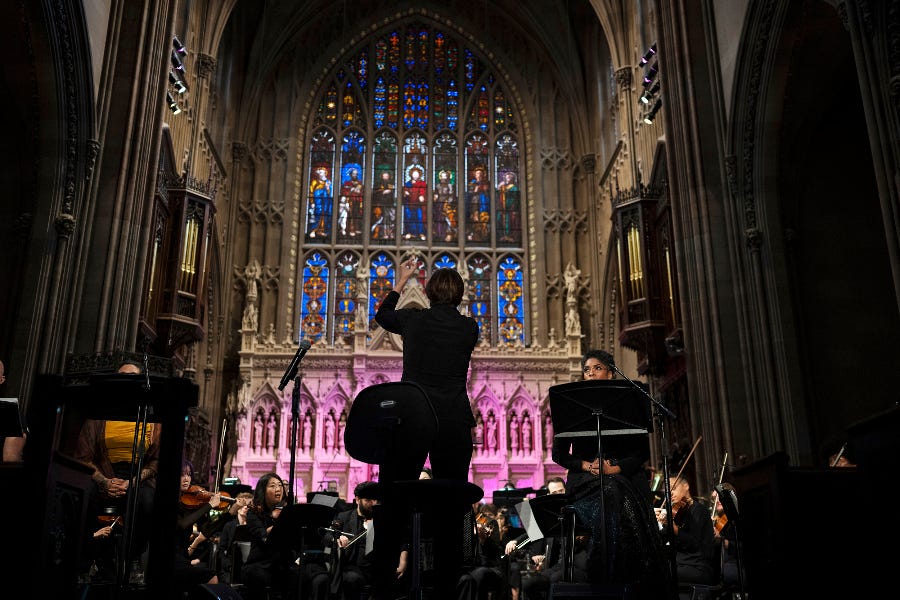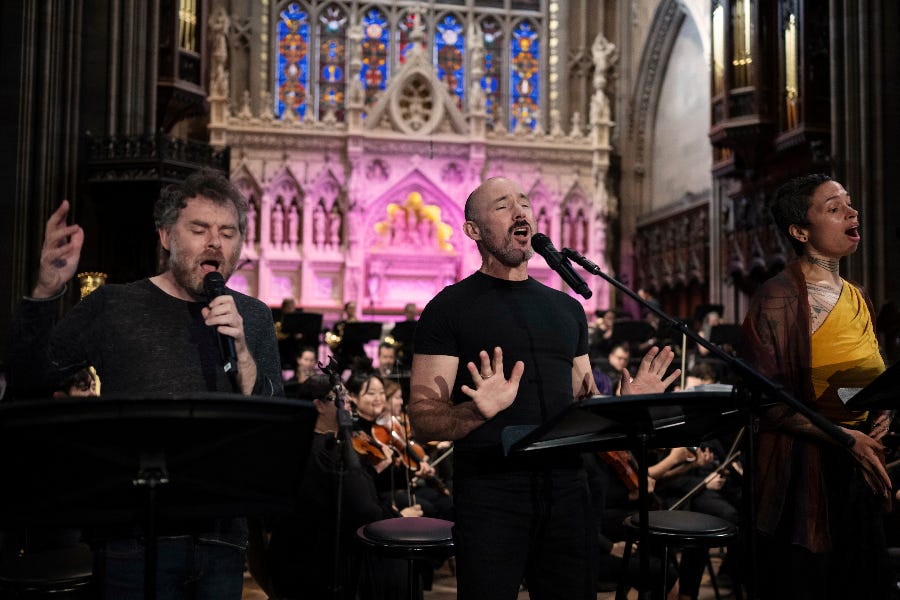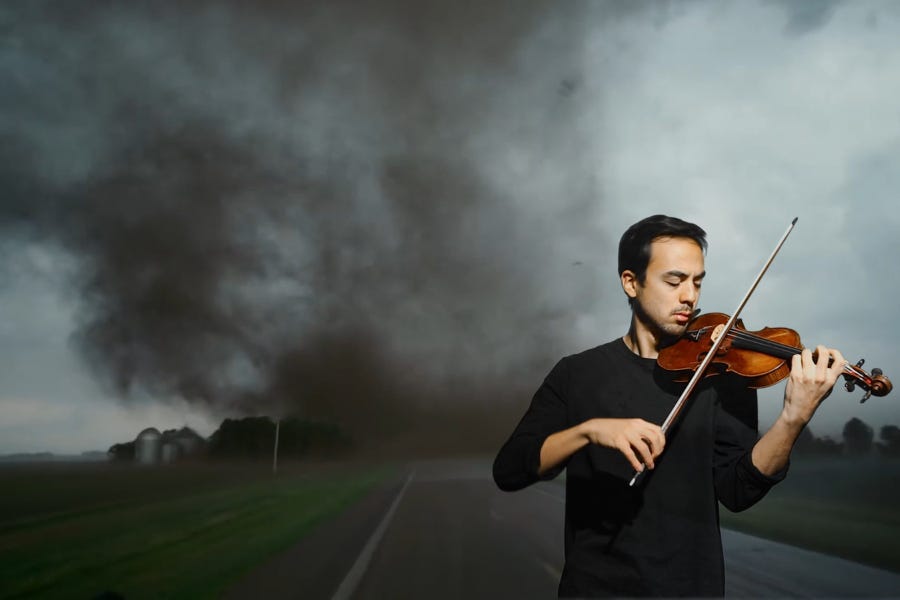It's about time.
Ruminations about coverage and its absence after a noteworthy musical event, plus recommended musical events for the week ahead.

I can’t overstate how frustrating it is to run out of time, over and over again, to write about the meaningful events I’m privileged to see. That’s especially true when the conventional media world takes a pass—or so it appears, anyway, regarding the New York City premiere of emergency shelter intake form, the complex, nuanced, beautiful, heartbreaking oratorio by Gabriel Kahane, presented last Thursday by Trinity Church Wall Street.
Of course, you can simply watch a video of the entire event, since it was streamed live and archived for precisely that purpose. And you should.
Is criticism thus irrelevant?
Maybe. But as a longtime observer of most of the artists involved, I certainly had things I’d love to have unpacked, starting with Kahane’s earnest, urgent message, his technical ingenuity and assurance with the orchestra, and his deft use of gestures reminiscent of Weill and Bernstein.

Similarly, a trenchant performance by Alicia Hall Moran transcended everything I knew from past experience of her singular, arresting artistry. Unorthodox supporting vocalists Holland Andrews and Holcombe Waller were noteworthy, as was the NOVUS ensemble under conductor Daniela Candillari. Even the setting, with choruses entering from side aisles, contributed to this uncanny event.
Immense praise to the Trinity Church Wall Street music program, and to music director Melissa Attebury – who granted me an interview last December, just as she was assuming her then-new role – not only for embracing this important work, but also for making it as a fundamental part of their mission, as evidenced in an enthusiastic, informed greeting by The Rev. Michael A. Bird.
This was an powerful, moving, and well-attended event that deserved wide coverage, but didn’t get any—precisely the motivation that prompted me to start blogging all those years ago, and just as frustrating now. But time remains a commodity that sometimes simply runs out, much as I wish otherwise.
News to note.
Two obituaries for baritone saxophonist and bandleader Claire Daly (full disclosure, a close family friend): Lara Pellegrinelli (full disclosure, my wife) for Down Beat, and Giovanni Russonello for The New York Times (gift link).
More about Claire Daly in a heartfelt testimonial by fellow musician Matt Lavelle on his illuminating newsletter, No Sound Left Behind.
The newest music critic to arrive on Substack is my friend and former New York Times freelance-stringer colleague Vivien Schweitzer, who starts not with observances about music, but reminiscences about canvassing.
Reviews to read.
George Grella on the Ives sesquicentennial and its broader implications, on Kill Yr Idols.
Ben Gambuzza on the Ives sesquicentennial – and on George Grella in re: same – on Evenings with the Orchestra.
Joshua Kosman on Esa-Pekka Salonen’s Cello Concerto and more, on On a Pacific Aisle.
The Night After Night Watch.
Concerts listed in Eastern Standard Time.
NOTAFLOF = no one turned away for lack of funds.
30
Ainadamar
Metropolitan Opera House, Lincoln Center
70 Lincoln Center Plaza; Upper West Side
Wednesday, Oct. 30 at 7pm; Saturday, Nov. 1 at 8pm; through Nov. 9; $35–$460
metopera.org
The brief, arresting opera by composer Osvaldo Golijov and playwright David Henry Hwang, concerning the life and work of poet-playwright Federico García Lorca, comes to the Met in a production by Deborah Colker. Angel Blue portrays Margarita Xirgu in most performances, Daniela Mack is García Lorca, and Miguel Harth-Bedoya conducts in his house debut.
American Composers Orchestra
Zankel Hall, Carnegie Hall
881 Seventh Ave., Midtown West
Wednesday, Oct. 30 at 7:30pm; $50–$60
carnegiehall.org
Mei-Ann Chen conducts the intrepid American Composers Orchestra in two world premieres, forest migrations by Paul Novak and Kebra-Seyoun Charles’s Bass Concerto (“Nightlife”) with the composer as soloist. Cellist Inbal Segev is featured in the New York premiere of Victoria Polevá’s The Bell, guitarist Mak Grgić plays the first local performance of Michael Abels’s Guitar Concerto (“Borders”), and violinist Curtis Stewart completes the bill with his own Embrace.
31
PinkNoise
Center for Performance Research
361 Manhattan Ave., Brooklyn
Thursday, Oct. 31 at 7:30pm; $15–$25 sliding scale
cprnyc.org
Qubit and CPR team up to present an evening-length concert of works by Rama Gottfried—appropriately abetted for the occasion with video, puppetry, and custom-made costumes by Brooklyn artist Sally Rumble.
1
Junction Trio
92NY
1395 Lexington Ave., Upper East Side
Friday, Nov. 1 at 7:30pm; $40–$60, livestream $25
92ny.org
The Junction Trio – violinist Stefan Jackiw, cellist Jay Campbell, and pianist Conrad Tao – performs the world premiere of John Zorn’s Philosophical Investigations II, on a program that also includes Dmitri Shostakovich’s Piano Trio No. 2 and Johannes Brahms’s Piano Trio No. 1. Livestream tickets are available for those unable to attend in person.
Yarn/Wire
DiMenna Center for Classical Music
450 W. 37th St., Midtown West
Friday, Nov. 1 at 8pm; $15–$30, students $5
yarnwire.org
Enterprising, polished, and unfailingly worthwhile, the quartet of pianists and percussionists Yarn/Wire present two auspicious new works: the world premiere of Diagrams of the Ear (Auditory Scene Analysis IV) by Eric Wubbels and the first U.S. performance of glass and stone by Clara Iannotta.
2
Ekmeles
DiMenna Center for Classical Music
450 W. 37th St., Midtown West
Saturday, Nov. 2 at 7:30pm; $20, seniors and students $15
ekmeles.simpletix.com
Ekmeles, a new-music vocal ensemble of otherworldly prowess and persuasion, opens its new season with a program titled “The Great Wall,” examining notions of language, distance, and love in world premieres by Charles Uzor and Bethany Younge, and a U.S. premiere by Petros Leivadas.
3
Keir GoGwilt & Celeste Oram
Blank Forms
468 Grand Ave. #1D, Brooklyn
Sunday, Nov. 3 at 4pm; $15
blankforms.org
Composers Keir GoGwilt and Celeste Oram present a program of collaborative works that wrest new sounds and statements from historical forms. Included in the mix is the strikingly timely Televisionmann, a 2017 elaboration on Georg Philipp Telemann’s Intrada-Suite for 2 Violins “Gulliver's Travels,” in which GoGwilt plays violin alongside a televised doppelgänger standing outside of then-Senator Kamala Harris’s San Diego office and amid protests against then-President Donald Trump’s so-called “Muslim ban” at the San Diego Airport. (See Tuesday, Nov. 5, for a related event.)
4
The Nebula Project
DiMenna Center for Classical Music
450 W. 37th St., Midtown West
Monday, Nov. 4 at 7pm; $25, students $10
chamberqueer.org
Luna Composition Lab and ChamberQUEER join forces in a new initiative meant to foster emerging composers of diverse identities. The first event, titled “Little Gems,” includes new works by Luna Lab alumni Lili Namazi and Sage Shurman, a new version of an original work by Devon Lee, and additional pieces by Luna alumni Caleb Palka, Jane Meenaghan, Alicia Erlandson, and Lucy Chen.
Tom Hamilton & Al Margolis
Sunview Luncheonette
221 Nassau Ave., Greenpoint
Monday, Nov. 4 at 8pm; by donation
Facebook
According to composer-performer David First, who’s done more than anyone in recent memory to boost awareness of the quirky Sunview Luncheonette – in its own words “a sometimes microvenue for art, poetics, regionalism, mutual aid, and commoning” – the converted Greenpoint diner might close permanently sometime soon. This showcase headlined by two inimitable veteran sound artists, Tom Hamilton and Al Margolis, with Suzana Lașcu and TJ Borden in support, provides excellent incentive to experience this unique setting.
5
If you haven’t already done it, vote.
More vital directories of new-music destinations:
Find even more events in Night After Night Watch: The Master List, here.
Photographs by Steve Smith, except where indicated.




The Times arts sections, including the listings, used to give a vivid sense of New York City as a *place,* where art was being made by active communities of creators in specific neighbourhoods and venues. That mattered to me as somebody who didn't live in NYC. It must have been even more valuable to locals. I get all the reasons why that ended. I've seen how reviews perform on online traffic dashboards: terribly. Any editor with a mandate to push coverage toward eyeballs would have made similar choices. But the Times arts pages today mostly cover cultural product that comes from nowhere. (They're also weirdly fixated on late-night comedy shows. Does anybody who didn't watch Jimmy Fallon last night give a rat's ass what he said about the campaign?) The idea that somebody might have done something interesting in a church last night would seem bizarre to today's editorial decision-makers. Again, I get the pressures driving this change, but it's a real loss.
You make a great case for venues such as this when one is looking for that type of criticism: evocative, thick description that helps you understand and feel what it was to be there to hear it. Even so, I think a Times mention still carries a lot of cachet for artists and their managers, and the reach that a small organization or emerging artist can achieve with coverage like that is still hard to match, which is unfortunate, given all that you and the above commentator have written about the shifting culture of criticism in print. The pendulum is still in swing, though.